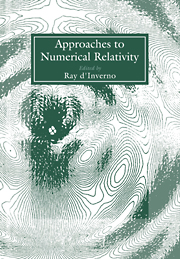Book contents
- Frontmatter
- Contents
- Contributors
- Introduction
- Preface
- PART A THEORETICAL APPROACHES
- PART B PRACTICAL APPROACHES
- Numerical asymptotics
- Instabilities in rapidly rotating polytropes
- Gravitational radiation from coalescing binary neutron stars
- “Critical” behaviour in massless scalar field collapse
- Godunov-type methods applied to general relativistic stellar collapse
- Astrophysical sources of gravitational waves and neutrinos
- Gravitational radiation from 3D gravitational stellar core collapse
- A vacuum fully relativistic 3D numerical code
- Solution of elliptic equations in numerical relativity using multiquadrics
- Self-gravitating thin discs around rotating black holes
- An ADI scheme for a black hole problem
- Time-symmetric ADI and causal reconnection
- The numerical study of topological defects
- Computations of bubble growth during the cosmological quark-hadron transition
- Initial data of axisymmetric gravitational waves with a cosmological constant
- PANEL DISCUSSION
Instabilities in rapidly rotating polytropes
Published online by Cambridge University Press: 15 December 2009
- Frontmatter
- Contents
- Contributors
- Introduction
- Preface
- PART A THEORETICAL APPROACHES
- PART B PRACTICAL APPROACHES
- Numerical asymptotics
- Instabilities in rapidly rotating polytropes
- Gravitational radiation from coalescing binary neutron stars
- “Critical” behaviour in massless scalar field collapse
- Godunov-type methods applied to general relativistic stellar collapse
- Astrophysical sources of gravitational waves and neutrinos
- Gravitational radiation from 3D gravitational stellar core collapse
- A vacuum fully relativistic 3D numerical code
- Solution of elliptic equations in numerical relativity using multiquadrics
- Self-gravitating thin discs around rotating black holes
- An ADI scheme for a black hole problem
- Time-symmetric ADI and causal reconnection
- The numerical study of topological defects
- Computations of bubble growth during the cosmological quark-hadron transition
- Initial data of axisymmetric gravitational waves with a cosmological constant
- PANEL DISCUSSION
Summary
Abstract. We review the classical and modern work on the stability of rotating fluid configurations with particular interest in astrophysical scenarios likely to produce gravitational radiation. We describe a hybrid method for numerically generating axisymmetric equilibrium models in rapid differential rotation based on the self consistent field approach. We include a description of the 3-D hydrodynamics code that we have developed to model the production of gravitational radiation, and present the results of a 3-D test case simulating the growth of the dynamical bar mode instability in a rapidly rotating polytrope.
INTRODUCTION
Overview
The study of the effects of rotation on equilibrium fluid bodies was begun by Newton in Book III of the Principia where he investigated the consequences of rotation on the figure of the earth, and concluded that the result would be a flattening at the poles to give the earth a slightly oblate shape. Much of the classical work accomplished since that time has been concerned with equilibrium configurations for fluids with uniform density and/or rigid rotation. Recent advances in computing technology, however, have allowed more detailed investigations involving differential rotation, various equations of state, and dynamical evolution of self gravitating systems. This work has fostered a variety of astrophysical applications, notably in the study of the formation of single and binary stars from collapsing gas clouds, and of the structure of compact objects, such as white dwarfs and neutron stars.
- Type
- Chapter
- Information
- Approaches to Numerical Relativity , pp. 163 - 181Publisher: Cambridge University PressPrint publication year: 1992



